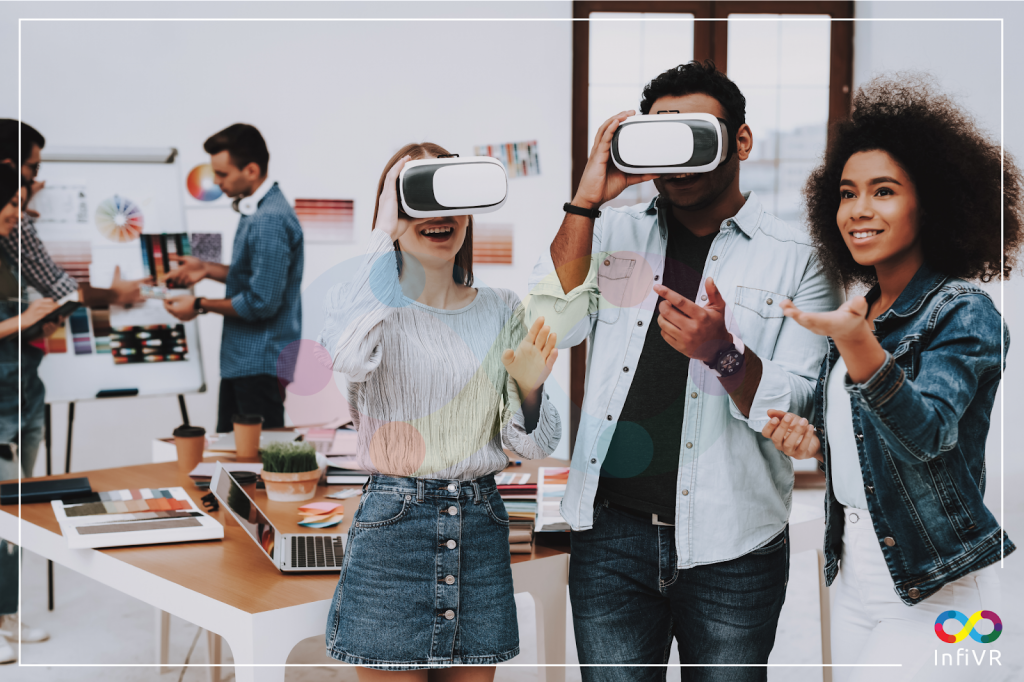Different types of environments in Virtual Reality Training
Virtual Reality (VR) training has become a popular tool in various industries due to its ability to create immersive, interactive, and safe training environments. These environments can be broadly classified into 3D virtual environments and 360-degree photography-based VR environments.
Let us dive deep into understanding each of these types and their impact on Virtual Reality Training.
3D virtual environment

3D Virtual Environments are computer-generated simulations replicating real-world scenarios, objects, and interactions in virtual reality (VR) training environments. These environments are created by modeling three-dimensional objects, surfaces, and spaces using specialized software tools, such as 3D modeling software.
In 3D Virtual Environments, trainees can experience a highly interactive and immersive learning environment. Moreover, the 3D models can be highly customizable, allowing trainers to create various simulations and training scenarios that would be expensive, difficult, or dangerous to replicate in the real world.
3D Virtual Environments also provide a high level of interactivity, allowing trainees to manipulate objects, perform actions, and experience real-time feedback. Trainees can interact with the environment using specialized input devices, such as VR controllers, haptic feedback devices, and motion tracking sensors. This allows them to develop their skills and understanding in a safe and controlled environment.
Another advantage of 3D Virtual Environments is that they can be used to simulate a range of real-world conditions and scenarios, including different weather conditions, lighting, and environmental hazards. This can provide trainees with a more comprehensive understanding of the real-world situations they may encounter in their job roles.
Researchers have explored the potential of 3D Virtual Environments for training and have identified the requirements and potential benefits of project-based instruction and collaboration. Research indicates that 3D Virtual Environments provide opportunities for increased shared presence, social interaction, and collaborative learning while lowering social anxiety and partially liquefying social boundaries.
There are mainly 3 types of 3D Virtual Environments
- Low-Fidelity 3D Virtual Environments
- Mid-Fidelity 3D Virtual Environments
- High Fidelity 3D Virtual Environments
Explore more about Virtual Reality Training with InfiVR:
At InfiVR, we revolutionize industrial training by seamlessly integrating virtual reality simulation and immersive 3D gamification experiences. Moreover, As proud partners to numerous Fortune 500 companies, we are committed to actualizing your next-generation training visions. Let’s collaborate to elevate your business through cutting-edge training solutions! For more information, feel free to reach out to our consultation experts at hello@InfiVR.com.
Want to know more:
- What is Virtual Reality?
- What is Virtual Reality Training?
- What is VR Simulation?
- Advantages of Virtual Reality Training?
- Applications of Virtual Reality Training.
- Virtual Reality Maintenance Training.
- Virtual Reality Inspection Training.
- Virtual Reality Operational Training.
- Virtual Reality Assembly Training
- Virtual Reality Support & Servicing Training
- Various types of Virtual Reality Training Mediums.
- Virtual Reality based Experiential Training
- Operational Virtual Reality Training
- Virtual Reality based Behavioral Training
- Different Types of Environments in VR Training – 3D Virtual Environment.
- Mixed Reality Virtual Environment.
- Spatial Virtual Environment.
- 360* Photography-based Virtual Environment.
- VR Training in the Aviation Industry.
- VR Training in the Aerospace Industry.
- VR Training in the Defence Industry.
- VR Training in the Oil & Gas Industry.
- VRTraining in the Warehouse Industry.
- VR Training in the Manufacturing Industry.
- Hardware Selections for Virtual Reality Training
- How to adopt virtual reality training for your company?
- How to look for a suitable partner for Virtual Reality Training development?
- How to develop Virtual Reality Training POC?
- How to assess the effectiveness and advantages of Virtual Reality Training POC implemented?
- How to develop Virtual Reality Training for full-scale implementation?
- Survey forms for feedback capture on VRT
- How to successfully draft a VR training RFP?